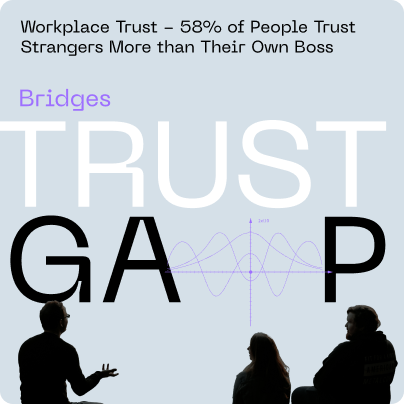Back in 2016, Harvard Business Review reported that 58% of people said they trusted strangers more than their own boss.
Fast forward to 2024, and trust in leadership hasn't improved. According to PwC’s latest Trust Survey, 70% of employees say they don't trust their company’s leaders to follow through on commitments.
Meanwhile, DoorDash handles over 7 million deliveries a day, and Airbnb hosts millions of guests in strangers’ homes. People are putting their dinner, their safety, and their vacations in the hands of people they’ve never met—but trust inside the workplace? Still in short supply.
Workplace Trust
Building trust in the workplace promotes confidence in a company's future. When workplace trust is strong, employees tend to work more effectively, engage with their teams, and contribute to greater overall productivity.
You could say trust is both a cause and a result of company culture. Every day, we make decisions—consciously or not—based on how much we trust one another. And with each decision, we either build trust or chip away at it.
So, where did workplace trust go? How can companies and managers go beyond surface-level efforts to rebuild it? And how are People Analytics professionals measuring, tracking, and improving employee satisfaction in a meaningful way?
This article doesn’t claim to have a silver bullet—but here are some solid KPIs worth keeping on your radar:
Absenteeism Rate
Employees who are present, on-time, and hitting their goals and deadlines are going to be more engaged, satisfied employees. Those who aren’t … well, they might not be singing the company's praises.
Monitoring absenteeism and cross referencing with other KPIs is a good place to start.
Employee Turnover Rate
While it's a common belief that employees leave organizations primarily for better pay, recent data suggests a more nuanced picture. According to a 2024 report by iCIMS, among employees planning to job hunt, the top reason cited was a higher salary.
However, it's essential to recognize that compensation is just one piece of the puzzle. Factors such as career advancement opportunities, work-life balance, and management quality also play crucial roles in employee retention.
Is the company conducting exit surveys? Tracking why employees are leaving is vital, in addition to measuring additional metrics such as turnaround under specific managers, departments, or within specific minority groups.
Is there a pattern in turnover? Perhaps a specific department, manager, or trigger event is responsible? Do you have predictive models that can help you internalize your data and answer the big questions?
Employee Net Promoter Score 
The Employee Net Promoter Score (eNPS) measures the likelihood of whether an employee would be willing to recommend your company as a great place to work and whether they would recommend the products or services your company creates. Employee Connect reported in 2023 that 59% of employees wouldn’t recommend theirs.
If you haven't yet started, track your eNPS. Then you can filter the data through a platform where you can see patterns and trends that could have affected the results.
Quick note: You can measure, track, and monitor trust-related trends across your organization using One Model’s People Analytics platform. Our tools help you uncover correlations between trust and key workforce metrics—like engagement, retention, and performance—so you can take data-driven action where it matters most.
Training
When your car runs out of gas, you don’t abandon it—you refill the tank and keep going.
Your team deserves the same consideration. According to the 2024 Training Industry Report, companies spent an average of $774 per learner in 2024, with variations based on company size. While these figures may seem modest, they primarily account for direct training expenses and may not include indirect costs such as lost productivity or administrative expenses.
Employees who opt into company-sponsored training—or are supported in pursuing outside education—tend to be more engaged in their roles, feel valued, and stay loyal. They’re also more likely to become promoters of your workplace, boosting your employee Net Promoter Score (eNPS) and fueling growth through word-of-mouth in their networks.
Building Trust in the Workplace with Predictive Workforce Data
Trust, engagement, and performance can all be tracked and improved—if you know where to look. With the right tools, companies can use their workforce data not just to react to trends, but to anticipate them.
If you're serious about strengthening company trust, it’s time to move beyond simple reporting and start using predictive modeling. These models help you surface hidden factors that erode workplace trust by:
Predicting Attrition
Identify which employees are likely to leave within the next 6–12 months, based on signals like manager changes, internal application outcomes, commute times, training engagement, and more. Strengthen company trust by addressing underlying issues before they escalate.
Spotting Manager Risk
See the warning signs that can quietly erode workplace trust under certain leaders or departments. Models can uncover red flags that deserve a closer look.
Optimizing Hiring Strategies
Which sourcing channels lead to high-performing hires? Are you bringing in the right people—or just the most available? Predictive hiring models can validate your recruiting efforts and help improve quality of hire.
How One Model Helps
One Model gives you the platform to bring these models to life. It integrates data from any source, cleans and normalizes it, and powers your analytics with clear, visual tools.
Whether you're using out-of-the-box predictive models or working with our team on something custom, you’ll have the infrastructure to build, scale, and evolve your analytics over time.
And when your data changes? Adding new sources or systems doesn’t mean starting over. One Model is built to flex with your ecosystem—no messy rebuilds required.
So if you're ready to move beyond dashboards and start asking bigger questions—like how to build company trust and drive long-term success—we're ready to help you answer them.
Explore more at onemodel.co, or reach out with questions. We love solving data problems.
Request a demo


